
|
|
 |

|


|
Toshiba REGZA 46SV670U Review
46" 1080p LCD HDTV, $2299
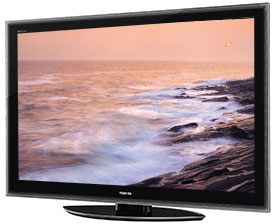
Dick De Jong Introduction
The REGZA 46SV670U is the flagship of Toshiba's LCD TV fleet and rightfully so. When it comes to picture quality artillery, this cruiser is armed with the big guns. The LCD panel on this 240Hz 46" TV is backlit by an array of LEDs with Local Dimming. I know that sentence is full of techno-jargon, which I will explain later. For now, just understand that the local dimming feature can produce deeper blacks which makes colors seem richer and whites whiter. The one item missing from the 46SV670U - and one I am coming to expect in Fall 2009 top of the line models - is Internet connectivity. This REGZA does not have a LAN port, which means that you cannot directly connect to the web and stream content. Of course, for many of us traditionalists who just want a great looking TV to watch our favorite DVDs and broadcast programs, the 46SV670U fits the bill. (Editor's Note: Toshiba also makes a 55" version of the SV670U series, the 55SV670U. Since both the 46" and 55" models have similar specifications, this review of the 46SV670U can apply to both.) Our Star Ratings
Performance: 5.0 If you prefer your picture deep and rich over snazzy and sharp, then this Toshiba 46SV670U with LED backlighting and local dimming deserves its 5 stars. The 4 star audio output from the integrated speakers simply does not compare with the picture quality.
Features: 4.0 When it comes to features, this REGZA is almost a throwback to 2007 when TVs were TVs and not widget filled Internet connected devices. For the videophiles, Toshiba provides one of the best picture adjustment tool sets around.
Ease of Use: 4.5 Since you don't need to worry about connecting the TV into your home network, setting up and operating the 46SV670U are much less complicated.
Value: 4.5 Even though Toshiba lists the 46SV670U at $2299, I just cruised the Internet and found it at a number of retailers for around $1650. At that price for a 46" LCD, you are still paying a premium, but you are buying top of the line LED backlighting technology with local dimming. In my opinion, the step up in picture quality makes the added cost worth it.
Star Ratings Description Ratings are relative to when the review was written. The obvious example is Value, what you could purchase for $2000 two years ago or even two months ago would seem like a bad value for that price now. We have given only a precious few 5 Star ratings, which we reserve for truly outstanding accomplishment.
Out of the Box
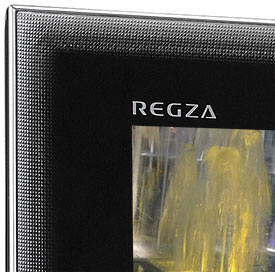
The most distinctive design feature of this REGZA is the outer edge of the two and a half inch bezel. Toshiba depicts it poetically, "Inspired by nature, Deep Lagoon evokes the image of sand disappearing below the surface of calm shores." Unlike most TVs with bezels that protrude slightly from the screen, the 46SV670U's front is covered edge-to-edge with a smooth surface. Toshiba describes it as anti-reflective, but I find it more reflective than a lot of LCDs that I have seen. Still, with the TV on, I really wasn't bothered by reflections. If you do see a light staring back at you, turn it off or you can rotate the TV (about 30 degrees left or right) on its swivel stand. Considering the 46SV670U weighs almost 73 pounds, the ability to twist it gives you some effortless flexibility with viewing angles. 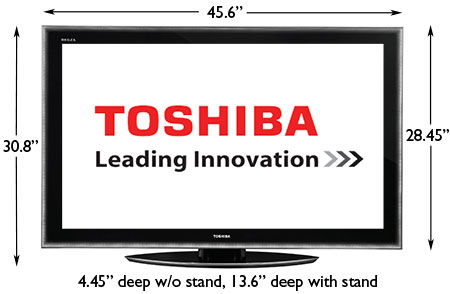 Toshiba parks its convenience panel of connections on the right edge of the TV just below the operational buttons. It contains one HDMI input, one Composite Video In with stereo Audio Ins, and a USB port for uploading JPEG photos, DIVX videos or MP3 songs. Also, on the side is an SD card slot where you can play JPEG photos but no music or video files. 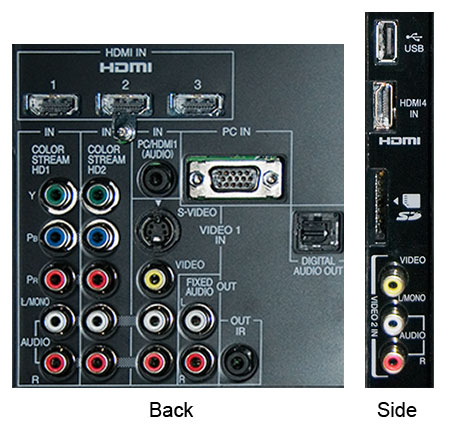 For sending audio to external speakers or a receiver, an SPDIF (optical) digital Audio Out is provided next to analog L/R Stereo Outs (with fixed volume). Also back there is an IR Pass-Through Port to control source devices that may be hidden out of line of sight to a remote control. Elsewhere on the back of the TV, the one RF antenna connector links to integrated NTSC/ATSC/QAM tuners. Since the tuner system is Clear QAM compatible, you can attach your cable TV signal directly into the RF connector and tune in unscrambled cable stations. The interface for playing back photos, videos and music is pretty basic. For example, with photos, no transition options are available, though you can set the slide duration time to 3, 5, 10, 15, 30, 60 or 90 seconds. In addition, you can't adjust the picture settings inside the photo menu. But it is a pleasure viewing your images on this LED backlit TV with local dimming. You are also limited to one format each for video (DIVX) and music (MP3). Since the 46SV670U does not offer a LAN port, I can skip a whole section about connecting to your home network and streaming content off the Internet. You simply can't do it directly through this REGZA. Now, I don't consider that as necessarily a demerit. Not having these features make the TV much simpler to setup and use. The TV also does not include Picture-in-Picture functionality. The important feature that this REGZA does possess is its LED Backlit with Local Dimming technology. If you are not familiar with these concepts, let me break them down. First, LED backlight. The 46SV670U is an LCD TV and like all LCDs, the panel is backlit, normally with CCFLs (cold cathode fluorescent lights). With this REGZA, the CCFL backlights are replaced with LEDs (light emitting diodes). This technique is fairly new with the first LED TVs appearing last year. Actually, designers of this type of display are placing the LEDs in two different locations. Right now, the more common method is to position the LEDs around the outer edge of the LCD, often called side light or edge-lit. The second method and the one that Toshiba employs with the 46SV670U is to place an array of LEDs behind the LCD panel, often termed direct. The advantage of this orientation is that it allows local dimming, though not all direct LED backlit TVs enable local dimming. One of the drawbacks of CCFL backlights is that they are a consistent even illumination. Ideally, if a part of the picture is dark, the TV could lower the brightness of the backlight accordingly. With the array of LED backlights, manufacturers are now able to locally dim the LEDs to match the image on the screen. 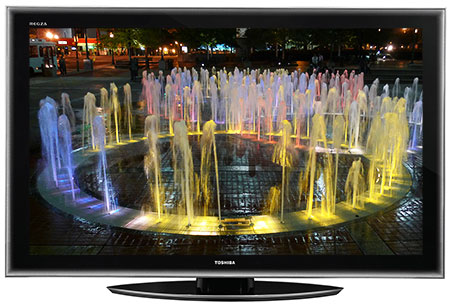 If part of the image is in deep shadow or totally black, the dimming will reinforce the darkness. Basically, the TV can produce darker darks, which makes colors seem richer. And since Contrast is measured as a ratio of the screen's whitest white to its blackest black, if a TV can generate a true black, then the Contrast skyrockets beyond 1,000,000 to 1. 
Of course, humans cannot perceive that wide range of contrast. I've read that its closer to 50,000 to 1. But since only a couple of years ago, LCD TVs were topping out at 10,000 to 1, you can see why people are excited about local dimming. The non-backlit remote control is a handful, even for my oversized mitts. But the designers did add a groove in the middle of the bottom for your index finger to grip. Most of the buttons on this multifunction remote are large with easy to read labels. The one oddity is that the three buttons around the navigation wheel serve two functions. For example, if you press the left side of the top button, it brings up the Favorites Browser. Click on the right side and the Setup Menu is revealed. I never had a problem using these controls. The manual is clearly written, though I would have preferred a little more information on the Advanced Video settings. But I assume that many people will never venture into that section of the Picture Settings Menu. Power Consumption
The EPA is now publishing a list of ENERGY STAR qualified TVs. (You can find it here.) The Toshiba REGZA 46SV670U is on the list. 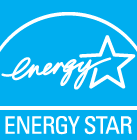
The EPA states that this Toshiba's On Mode Power is 135W and Standby Power Consumption is .03W. Based on the formula that the TV is on five hours a day and in Standby for the other 19, the Estimated Annual Energy Use is 248 kWh/year. You need to check your electric bill to see how much you are paying for a kWh. The rate that I have been using in previous reviews is 10.4 cents. Doing the multiplication, at that rate, the yearly energy cost is $25.79. Since manufacturers are not attaching those yellow ENERGY STAR tags that you find on air conditioners and refrigerators, you will have to study the ENERGY STAR list to see how the 46SV670U compares to other 46" TVs. LED backlit TVs are gaining a reputation for their lower than average energy consumption. A quick overview of other 46" non-backlit LED TVs seem to substantiate that claim. For example, Toshiba has two 46" models on the list right next to this REGZA and they each consume about 50% more kWh than the 46SV670U. Setup
To calibrate the TV, we use two discs, the Blu-ray version of the Digital Video Essentials DVD called HD Basics and the Spears & Munsil High Definition Benchmark Blu-ray DVD. We are playing the DVDs on the OPPO BDP-83 Blu-ray player connected to the HDTV with an HDMI cable. We use the test patterns to adjust black level, white level, and color bias. The player is set to output a 1080p signal, which is the native resolution of the 46SV670U. Before I start, let me say that this REGZA has some of the best fine tuning tools that I have encountered. For those who wish to tweak the dickens out of test patterns, this is a TV for you. Now, if you just want to pull the TV out of the box, plug it in and watch the big game, then choose one of the default Picture modes. Toshiba offers six: AutoView, Sports, Standard, Movie, Games, and PC. Even for football or futbol, I would avoid Sports because the picture is just too bright. The field looks overfertilized. I suggest Standard. For the cinephile in a darkened viewing room, definitely try Movie. Though you may want to bump up the Brightness a notch or two. 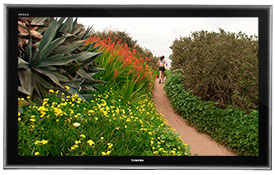
If you want to follow me into the trenches, I picked Standard as my jumping off point and went into the Advanced Picture Settings and turned everything like Dynamic Contrast to Off. Next, I set the Color Temperature, which is in the Advanced Settings Menu. Even with this adjustment, you can begin to see the amount of control that Toshiba is giving you. Usually, the choices are Cool, Normal and Warm. The 46SV670U offers a slider from 0 to 10. 0 being Warmest Warm and 10 being Coolest Blue. Standard mode defaults to 7. I pushed it to a neutral 5. As a reference, Movie mode defaults to 2. I then went back to the first page of the Picture Settings menu and turned down the Backlight to 40 (out of 100). Lowering the Backlight saves electricity. Your number may vary depending on the lighting conditions in your room. According to the test patterns, I notched Brightness up to 7. I dropped Contrast (Picture) to 70. I lowered Color (Saturation) to around -15, and Tint (Hue) ended up at 7. The Sharpness scale runs from -50 (Min) to 50 (Max). When looking at a Safe Zone test pattern, I noticed the beginning of fringing at 0. Ultimately over-sharpness is in the eye of the beholder. I tend to prefer images that are not artificially sharp, therefore I went with -10. I must admit that I have a bit of checkered history with this TV. I set it up a couple of weeks ago and didn't write the review because I had a number of technical questions that needed to be answered. During that time, I watched a few programs and marveled at the deep blacks that the local dimming was producing. I then went to CEDIA, where I saw a great demonstration of this TV side-by-side an LCD that was not LED backlit. Returning back to the office, I decided to recalibrate the TV just to check my settings. It was during that session that I started investigating some of the fine tuning features. For example, in the appropriately labeled Expert Mode submenu, you can turn off the Red, Green or Blue components of the picture. Calibration DVDs usually come with a blue filter which helps you adjust the color of the display. You can achieve the same effect by disabling Red and Green in this menu. The one disadvantage to this tool is that it flips back to full color when you exit this menu. 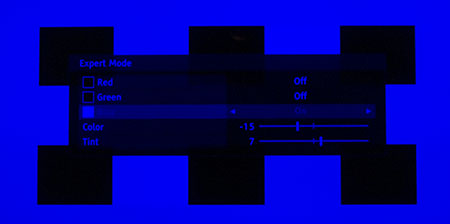 Color Bars with Only Blue Enabled in Expert Mode If you turn On the ColorMaster feature, you can then go into the Base Color Adjustment and set Hue, Saturation and Brightness for individual R, G, B, C, M, and Y colors. I found these sliders to be responsive. 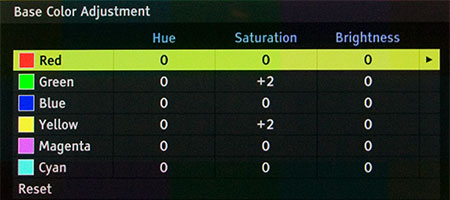 I decided not to futz with the Backlight Adjustment Pro tool, mostly because the picture already looked good and partly because the manual gave minimal insight in how it worked. Basically, you will have to experiment with tools like Dynalight and Static Gamma to see if they suit your eye. I left them alone. I did take a clue from the Movie default and set Dynamic Contrast to 3. Finally, the 46SV670U sports a 240Hz LCD panel. Toshiba uses backlight scanning to jump from 120 Hz to 240. VIZIO employs the same technique and I have discussed the technology in detail in my review of the VIZIO SV471XVT. Please read it if you need a refresher. 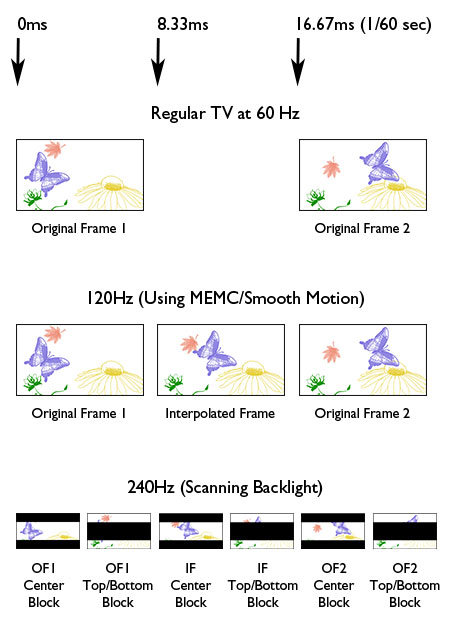 I want to talk about two settings that influence how this Toshiba deals with interpolation and backlight scanning. Both are fairly straightforward. The ClearScan 240 setting is either Off or On. Turn it Off and the TV interpolates the original 60 frames to make 120, but backlight scanning to 240 is disabled. Turn it On and backlight scanning is enabled. The Film Stabilization feature effects 24p content. When turned to Standard, the display simply repeats a frame five times to reach 120Hz. In Smooth, the MEMC (motion estimation, motion compensation) technology interpolates to reach 120Hz. I honestly did not see much difference between ClearScan On or Off or Film Stabilization set to Standard or Smooth. None of the settings caused any annoying artifacts. Experiment with the different combinations to see which you prefer. Performance
I'm a devotee of deep blacks, which is why I'm rooting for plasmas to survive. LED backlit TVs with local dimming are quickly approaching black levels that previously only plasmas could produce. A picture with deep blacks is not always as flashy as a super bright, super sharp screen. In fact, when I first was watching this Toshiba, the deep black sensation snuck up on me. I think I was viewing something as visually mundane as Jeopardy (broadcast over-the-air) when I noticed the rich colors. Then everywhere I turned, I started appreciating the wide range of contrast. (Toshiba states an astounding 2,000,000:1 Dynamic Contrast ratio for the 46SV670U, which is way beyond my visual capabilities.) 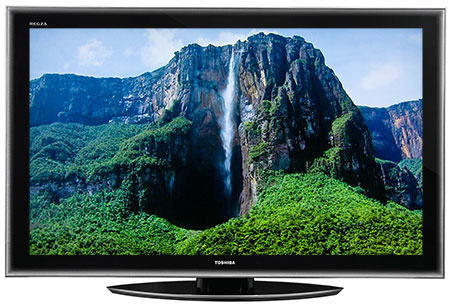 What I can perceive are luscious colors in content like Dreamgirls and the Earth Blu-ray DVD. Before I go to ga-ga, I realize that this type of picture might not be the cat's meow for everyone. Some may prefer the almost 3D-like clarity that I have seen in other 240Hz LCDs. I am not as enthusiastic about the audio performance. It's fair, good enough for everyday TV viewing. But as deep as the picture is, the audio lacks the punch in the low registers. It tends to be too bright and brassy. The Advanced Sound Features did add depth and breadth to the audio, but to match the picture quality, you need to spring for a dedicated audio system. 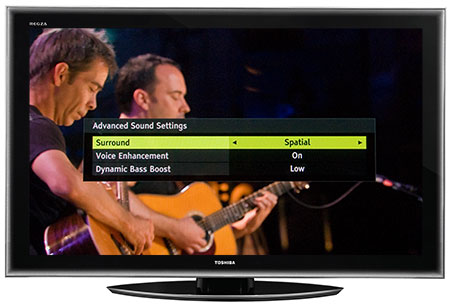 Conclusion
The Toshiba REGZA 46SV670U showcases state-of-the-art LCD technology with a 240Hz LED backlit panel with local dimming, which produces deep blacks and rich colors. The TV is not Internet connected. |
Bookmark:
![]() del.icio.us
del.icio.us
![]() Reddit
Reddit
![]() Google
Google
Reader Comments
| Send this Page | Print this Page | Report Errors |


Posted Apr 15, 2013 7:37:34 PM
By aristides cabreja